

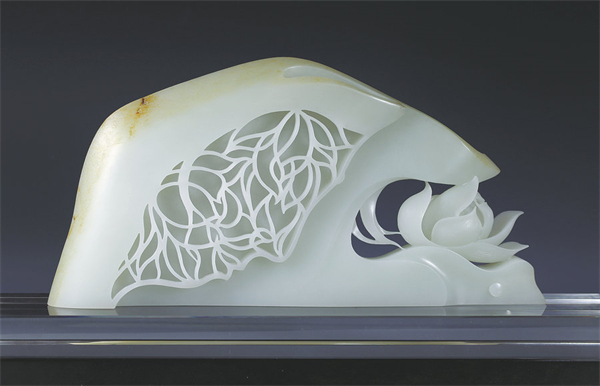
A Buddhist-themed jade carving by Yang is among the British Museum's permanent collection. [Photo provided to China Daily]
On par with the Qing Dynasty (1644-1911) Emperor Qianlong's high-profile love for calligraphy and paintings is his fascination with jade. During his reign from 1736 to 1796, the emperor's obsession led to an unprecedented elevation in jade craftsmanship.
In his lifetime, Emperor Qianlong wrote around 800 poems in appreciation of jade that expressed his joy and admiration of craftsmanship, especially when he received a truly precious piece.
Among the numerous jade artifacts that caught the emperor's eye and inspired his poetry were Hindustani jade vessels originating from the Mughal Empire, which ruled India from the 16th to 19th centuries.
These eggshell-thin, almost translucent, items, such as bowls, plates, teapots, vases and incense burners, featuring novelty shapes and intricately carved floral and foliage patterns, were well-polished and sometimes inlaid with gold, silver and gems.
To expand production, the emperor summoned veteran craftsmen from Jiangnan, the region south of the lower reaches of the Yangtze River — Suzhou and Yangzhou in today's Jiangsu province in particular — to the imperial court.
For thousands of years, this region, rich in elegance and literati temperament, has been filled with artisans whose carvings have realized the material's imagery association with human virtue.
In his later years, Emperor Qianlong made the decision to cease the production of the delicate and resource-intensive Hindustani style due to its high costs in raw materials, labor, and time. Subsequently, the craft was gradually forgotten.
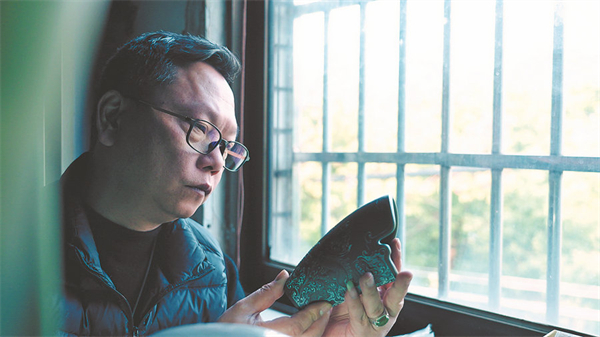
Yu Ting, 51, has been in the field of jade carving for 37 years. [Photo by Tian Zhengchun/For China Daily]
Miniature artwork
Nevertheless, a modern generation of craftsmen is tempted to restore and further refine this mysterious, superb skill. Among those investing constant efforts is Suzhou-based jade carver Yu Ting, 51, whose journey began when he discovered a book on Hindustani jade and an eggshell-thin fragment at the beginning of the century.
"Historical records say that vessels with a thickness of less than 1.6 millimeters could be called eggshell jade but, thanks to improved tools, we can now make them thinner than 1 mm, even as thin as 0.5 to 0.6 mm," he says.
In his studio in western Suzhou, where his jade pieces are displayed, he arranges lights behind these vessels, so visitors can observe the thin surface with its delicately carved patterns, and the glossy, even inner walls.
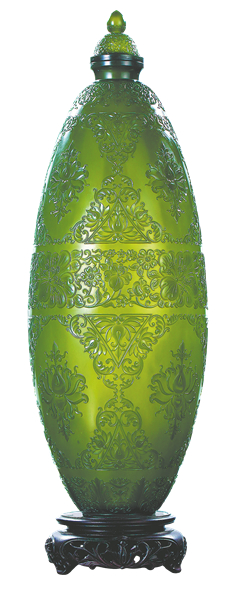
A 34-centimeter-tall jade bottle with a surface of around 1 millimeter thin by Suzhou-based carver Yu Ting. [Photo provided to China Daily]
He is very proud of a 34-centimeter-tall bottle with a small mouth and bulging belly, the shape inspired by short columns on the beams of traditional architecture in suburban Suzhou.
Yu and his team spent three years producing this bottle, which weighs only 478 grams and is made from a raw material of 39 kilograms. The belly is 11 cm in diameter and the mouth is just 2 cm. They had to apply mini tools to hollow out the interior a little at a time, "like cleaning ears", he says.
While hollowing out this piece, the artisans could barely see the inside and had to rely largely on feeling with their hands. Yu explains that it's a risky process to make eggshell jade pieces, as a slight tremble may puncture the whole piece.
The surface of the bottle is adorned with symmetrical relief patterns featuring intertwined winter jasmine and lotus, both bearing auspicious meanings in traditional Chinese culture.
Variations in color result from the change in thickness of the carvings on the green nephrite — with the thinner part being lighter and the thicker part with relief patterns appearing much darker.
The eggshell jade master is just one practitioner striving to protect the millennia-long prosperity of antique craftsmanship in Suzhou.
Late Ming Dynasty (1368-1644) scientist Song Yingxing wrote in his masterpiece Tiangong Kaiwu (The Exploitation of the Works of Nature) that although fine jade materials were always brought to the capital, Suzhou possessed the most exquisite craftsmanship.
According to Ma Jianting, president of the Suzhou Arts and Crafts Industry Association, regional characteristics of jade carving, as well as the exchange and integration of craftsmanship, have lasted throughout the modern era.
For example, artisans in the north have inherited the traditional style of grand, complex royal pieces. Jade artisans in Yangzhou, historically taking advantage of the convenient transportation of raw materials by the Grand Canal, are good at carving large pieces such as mountains.
Suzhou-based carvers, on the other hand, are focused on smaller pieces with delicate, reserved designs that resonate with the city's gentle atmosphere, says Shan Cunde, the association's deputy secretary-general.
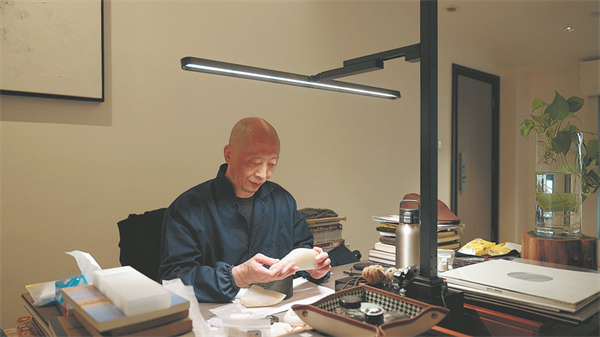
Yang Xi, 60, a national-level intangible cultural heritage inheritor of jade carving in Suzhou, Jiangsu province. [Photo by Tian Zhengchun/For China Daily]
Poetic portrayal
Representative jade carving works of Yang Xi, 60, a national-level intangible cultural heritage inheritor, include a depiction of the Avalokiteshvara Bodhisattva (Thousand-Hand Bodhisattva).
Unlike many large figurative Buddhist sculptures, this desk ornament features a meditating Bodhisattva with the face and dozens of hands in diverse shapes and gestures, leaving the body up to the imagination.
As the slender fingers are prone to damage, Yang carved from the middle to side, with the central hands appearing three-dimensional and those on the sides similar to embossment.
With an educational background in painting and sculpturing, the carver borrows traditional Chinese ink painting concepts of combining reality and illusion, achieving more with less in his jade carving works.
Having spent his early years in the city's historical Pingjiang Road neighborhood, Yang has also created a series of nephrite works inspired by the water town's crisscrossing waterways, arch bridges and rows of black-tiled, white-painted residences.
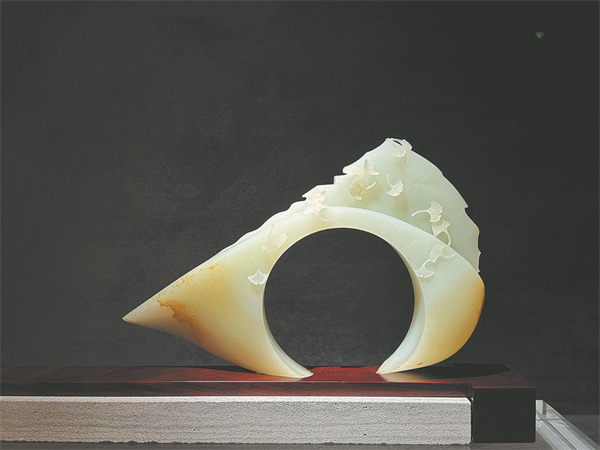
One of Yang's works inspired by ginkgo leaves and arch bridges. [Photo by Fang Aiqing/China Daily]
Designed and carved according to the original color, shape and texture of jade materials, delightful golden ginkgo leaves dancing in the breeze are revived on the jade ornaments. The leftover materials used to make bracelets have been cleverly transformed into arch bridges.
"These are my most cherished hometown memories. Jade carving has great potential to vividly convey lines and blocks, as well as artistic impressions; the key lies in realizing it," he says.
On another piece, some irregular white blemishes are perceived to depict an elderly hermit riding a donkey on his way back to his mountain cabin during a snowy night followed by a young disciple. This is a classical literary theme that praises solitude, resilience and remaining aloof from the crowd.
In jade carving, it's always worthwhile to take on the challenge of transforming worthless materials into more valuable pieces of art, says Yang.
Industry insiders in Suzhou have reached a consensus that the craftsmanship has to keep up with contemporary aesthetics and concerns, while drawing nourishment from other sectors of arts and crafts, says Ma.
To better master the trick of making teapots and utensils, Yu says he has been to the city of Yixing in Jiangsu to learn its celebrated purple clay teaware techniques — balancing the design of the spout, handle and pot, drawing more practical sketches, and how to appropriate the various shapes into his jade pieces.
For a practitioner with four decades in the field, Yang says he is no longer bothered by technical challenges but focuses on breaking away from existing themes and expressions and not repeating his previous creations.
Works of both Yang and Yu have made their way to the British Museum's permanent collection, representing contemporary Chinese jade carving craftsmanship of the 21st century.
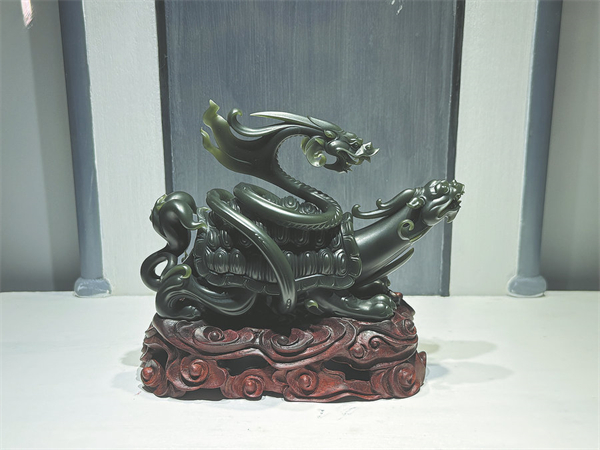
A jade piece by Yu featuring xuanwu, a Chinese mythical creature that's sometimes depicted as a snake coiling around a tortoise. [Photo by Fang Aiqing/China Daily]
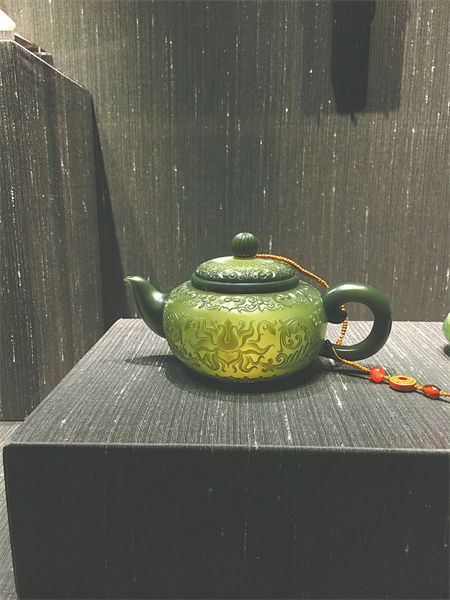
A teapot by Yu, decorated with intertwined floral and foliage patterns, has been collected by the British Museum. [Photo provided to China Daily]

